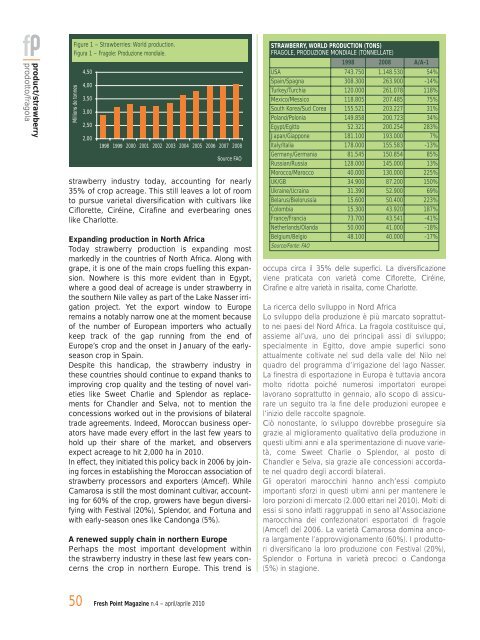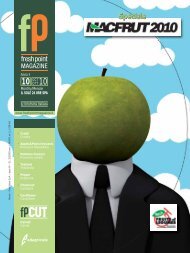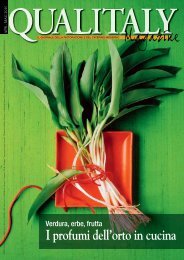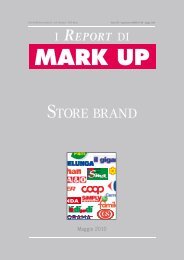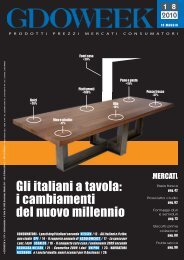Fresh Point Magazine - B2B24 - Il Sole 24 Ore
Fresh Point Magazine - B2B24 - Il Sole 24 Ore
Fresh Point Magazine - B2B24 - Il Sole 24 Ore
You also want an ePaper? Increase the reach of your titles
YUMPU automatically turns print PDFs into web optimized ePapers that Google loves.
product/strawberry<br />
prodotto/fragola<br />
Figure 1 – Strawberries: World production.<br />
Figura 1 – Fragole: Produzione mondiale.<br />
Millions de tonnes<br />
4,50<br />
4,00<br />
3,50<br />
3,00<br />
2,50<br />
2,00<br />
1998 1999 2000 2001 2002 2003 2004 2005 2006 2007 2008<br />
strawberry industry today, accounting for nearly<br />
35% of crop acreage. This still leaves a lot of room<br />
to pursue varietal diversification with cultivars like<br />
Ciflorette, Ciréine, Cirafine and everbearing ones<br />
like Charlotte.<br />
Expanding production in North Africa<br />
Today strawberry production is expanding most<br />
markedly in the countries of North Africa. Along with<br />
grape, it is one of the main crops fuelling this expansion.<br />
Nowhere is this more evident than in Egypt,<br />
where a good deal of acreage is under strawberry in<br />
the southern Nile valley as part of the Lake Nasser irrigation<br />
project. Yet the export window to Europe<br />
remains a notably narrow one at the moment because<br />
of the number of European importers who actually<br />
keep track of the gap running from the end of<br />
Europe’s crop and the onset in January of the earlyseason<br />
crop in Spain.<br />
Despite this handicap, the strawberry industry in<br />
these countries should continue to expand thanks to<br />
improving crop quality and the testing of novel varieties<br />
like Sweet Charlie and Splendor as replacements<br />
for Chandler and Selva, not to mention the<br />
concessions worked out in the provisions of bilateral<br />
trade agreements. Indeed, Moroccan business operators<br />
have made every effort in the last few years to<br />
hold up their share of the market, and observers<br />
expect acreage to hit 2,000 ha in 2010.<br />
In effect, they initiated this policy back in 2006 by joining<br />
forces in establishing the Moroccan association of<br />
strawberry processors and exporters (Amcef). While<br />
Camarosa is still the most dominant cultivar, accounting<br />
for 60% of the crop, growers have begun diversifying<br />
with Festival (20%), Splendor, and Fortuna and<br />
with early-season ones like Candonga (5%).<br />
A renewed supply chain in northern Europe<br />
Perhaps the most important development within<br />
the strawberry industry in these last few years concerns<br />
the crop in northern Europe. This trend is<br />
50 <strong>Fresh</strong> <strong>Point</strong> <strong>Magazine</strong> n.4 – april/aprile 2010<br />
Source FAO<br />
STRAWBERRY, WORLD PRODUCTION (TONS)<br />
FRAGOLE, PRODUZIONE MONDIALE (TONNELLATE)<br />
1998 2008 A/A-1<br />
USA 743.750 1.148.530 54%<br />
Spain/Spagna 308.300 263.900 -14%<br />
Turkey/Turchia 120.000 261.078 118%<br />
Mexico/Messico 118.805 207.485 75%<br />
South Korea/Sud Corea 155.521 203.227 31%<br />
Poland/Polonia 149.858 200.723 34%<br />
Egypt/Egitto 52.321 200.254 283%<br />
Japan/Giappone 181.100 193.000 7%<br />
Italy/Italia 178.000 155.583 -13%<br />
Germany/Germania 81.545 150.854 85%<br />
Russian/Russia 128.000 145.000 13%<br />
Morocco/Marocco 40.000 130.000 225%<br />
UK/GB 34.900 87.200 150%<br />
Ukraine/Ucraina 31.390 52.900 69%<br />
Belarus/Bielorussia 15.600 50.400 223%<br />
Colombia 15.300 43.920 187%<br />
France/Francia 73.700 43.541 -41%<br />
Netherlands/Olanda 50.000 41.000 -18%<br />
Belgium/Belgio<br />
Source/Fonte: FAO<br />
48.100 40.000 -17%<br />
occupa circa il 35% delle superfici. La diversificazione<br />
viene praticata con varietà come Ciflorette, Ciréine,<br />
Cirafine e altre varietà in risalita, come Charlotte.<br />
La ricerca dello sviluppo in Nord Africa<br />
Lo sviluppo della produzione è più marcato soprattutto<br />
nei paesi del Nord Africa. La fragola costituisce qui,<br />
assieme all’uva, uno dei principali assi di sviluppo;<br />
specialmente in Egitto, dove ampie superfici sono<br />
attualmente coltivate nel sud della valle del Nilo nel<br />
quadro del programma d’irrigazione del lago Nasser.<br />
La finestra di esportazione in Europa è tuttavia ancora<br />
molto ridotta poiché numerosi importatori europei<br />
lavorano soprattutto in gennaio, allo scopo di assicurare<br />
un seguito tra la fine delle produzioni europee e<br />
l’inizio delle raccolte spagnole.<br />
Ciò nonostante, lo sviluppo dovrebbe proseguire sia<br />
grazie al miglioramento qualitativo della produzione in<br />
questi ultimi anni e alla sperimentazione di nuove varietà,<br />
come Sweet Charlie o Splendor, al posto di<br />
Chandler e Selva, sia grazie alle concessioni accordate<br />
nel quadro degli accordi bilaterali.<br />
Gli operatori marocchini hanno anch’essi compiuto<br />
importanti sforzi in questi ultimi anni per mantenere le<br />
loro porzioni di mercato (2.000 ettari nel 2010). Molti di<br />
essi si sono infatti raggruppati in seno all’Associazione<br />
marocchina dei confezionatori esportatori di fragole<br />
(Amcef) del 2006. La varietà Camarosa domina ancora<br />
largamente l’approvvigionamento (60%). I produttori<br />
diversificano la loro produzione con Festival (20%),<br />
Splendor o Fortuna in varietà precoci o Candonga<br />
(5%) in stagione.


